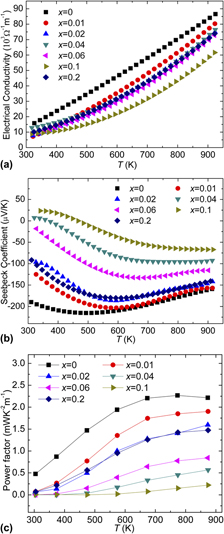Article contents
P-type doping of Hf0.6Zr0.4NiSn half-Heusler thermoelectric materials prepared by levitation melting and spark plasma sintering
Published online by Cambridge University Press: 11 May 2011
Abstract

The Y-doped (Hf0.6Zr0.4)1-xYxNiSn (x = 0, 0.01, 0.02, 0.04, 0.06, 0.1, and 0.2) half-Heusler alloys have been prepared by levitation melting and spark plasma sintering. The effect of Y doping on thermoelectric properties of the alloys was investigated in the temperature range of 300–900 K. Y-doped samples had the lower electrical conductivity compared with the parent compound without Y doping. The thermal conductivity had weak dependence on Y doping content. The absolute values of Seebeck coefficient decreased significantly when x < 0.04. The sign of Seebeck coefficient turned from negative to positive at room temperature for x = 0.04 and 0.1, which means that the hole carriers became dominant in these alloys. However, the alloys changed to n-type conduction again at high temperatures. The maximum figure of merit value of about 0.45 was obtained at 780 K for the undoped sample.
- Type
- Articles
- Information
- Journal of Materials Research , Volume 26 , Issue 15: Focus Issue: Advances in Thermoelectric Materials , 14 August 2011 , pp. 1913 - 1918
- Copyright
- Copyright © Materials Research Society 2011
References
REFERENCES
- 3
- Cited by




